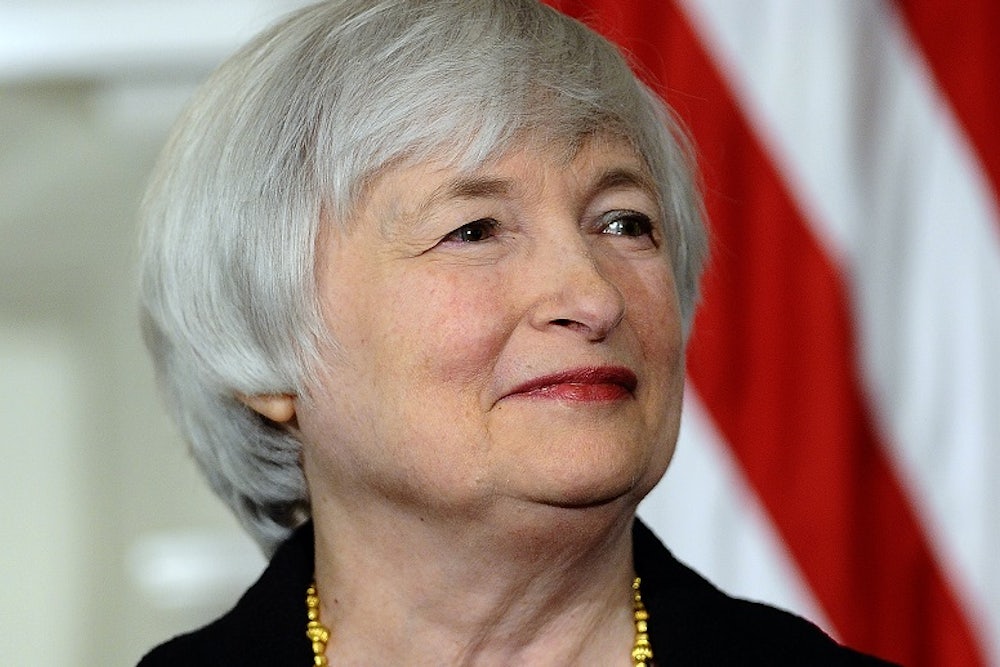Monetary policy’s biggest party of the year gets underway in Jackson Hole, Wyoming today when some of the world’s leading economists meet for a three day conference. The topic du jour is the state of the U.S. labor market. I know—it sounds awfully technical and wonky for a morning newsletter. But bear with me. What happens at this meeting will have huge implications for the economy—and, ultimately, the wages of ordinary Americans.
In the next few months, the Federal Reserve will end its highly publicized and sometimes controversial quantitative easing program. Under that program, the Fed purchased billions of dollars of Treasury bills and mortgage-backed securities, in order to spur economic growth. Now, the main question facing monetary economists is when to start raising interest rates. Since 2009, the Fed has kept interest rates at zero. The idea was that low interest rates would encourage businesses to invest in new equipment while making it easier for consumers to borrow money for new homes and cars. That money would filter down through companies into the pockets of ordinary Americans, like waiters and construction workers. But the Fed can’t keep interest rates at zero forever. As the economy recovers, such low interest rates could lead to high inflation.
The Fed, led by chair Janet Yellen, is trying to decide when that should happen. But this is not an exact science. It depends on which economic indicators you trust most. For instance, the unemployment rate has fallen to 6.2 percent, nearing its long run rate. By that metric, the economy is nearing full employment and will overheat soon. But other statistics, like the labor force participation rate, tell a different story. That’s the number of Americans, as a percentage of the working-age population, either working or looking for work. It’s well below its pre-recession peak. Part of that is due to demographic changes: As the country ages, a lower percentage of the population will be working. But some of it is remnants of the Great Recession, like discouraged workers who aren’t currently searching for work, but want a job. They don’t show up in the official unemployment rate, but as the economy improves, they will be drawn back into the labor force.
Given the disconnect between different measures of the U.S. labor market, it may seem difficult to craft the optimal monetary policy. But it’s not. That’s because the downside risks are not equal. If the Fed is late raising rates, moderate inflation will follow. That’s not ideal, but it isn’t the end of the world, either. But if the Fed raises rates too soon, it will stifle the recovery. The millions of Americans—teachers, fast food workers and many others—who haven’t seen their income rise in years will continue to see their wages stagnate.
That would be devastating to everyday Americans, but already there are economists, like Dallas Fed President Richard Fisher, who are so concerned about inflation that they want to raise rates now. Financial analysts outside of the Fed, like CNBC’s Rick Santelli, are also clamoring for the Fed to tighten policy. So far, Yellen has done an excellent job of ignoring Fisher, Santelli, and the rest of the inflation hawks. At 10 a.m. this morning, when Yellen gives a speech at Jackson Hole that will signal her intentions, she’ll have another chance to brush off their bad advice—and to demonstrate her commitment to American workers.
—Danny Vinik
News from Thursday:
FERGUSON: Another night of relative calm reigned over Ferguson on Thursday as Governor Jay Nixon began withdrawing some of the National Guard. There were still some arrests and the police used tear gas, but not rubber bullets. No Molotov cocktails were thrown. (Carol D. Leonnig and William Branigin, Washington Post)
POVERTY: Based on an analysis of presidential budget proposals, Tali Mendelberg and Bennett Butler show that President Obama has tried harder to help low-income Americans than any president in the last half-century. (New York Times)
TOXINS: Pollutants like benzene, mercury, and lead are way, way down in American cities since the 90s, according to an Environmental Protection Agency announcement on Thursday. (Reuters)
Articles worth reading:
Front lines in the abortion wars: Sarah Kliff takes readers inside Mississippi's only remaining clinic. (Vox)
Going ballistic: A federal judge is about to eliminate D.C.'s ban on the open carry of firearms. Timothy Noah explains why that's a really bad idea. (MSNBC)
An Obamacare problem in California? Last year, the state's marketplace had 13 plans. This year, it will have ten. Will the reduced competition be bad for consumers? Dan Diamond tries to figure it out. (California Healthline)
Thanks, Congress: Instead of taking the ice bucket challenge, Congress could restore funding to the National Institutes of Health. Between inflation and the sequester, its budget has effectively fallen 22 percent in the past decade. (Jason Millman, Wonkblog)
Stories we’ll be watching:
Yellen’s 10 a.m. speech. And Ferguson.
At QED:
Jonathan Cohn argues that Robert McCulloch, the prosecutor in the Michael Brown case, should step aside and allow Governor Jay Nixon to appoint a special prosecutor. The black community simply doesn’t trust McCulloch to be impartial. And did you know that all of the U.S.’s new electricity in July came from renewables? Rebecca Leber explains.
